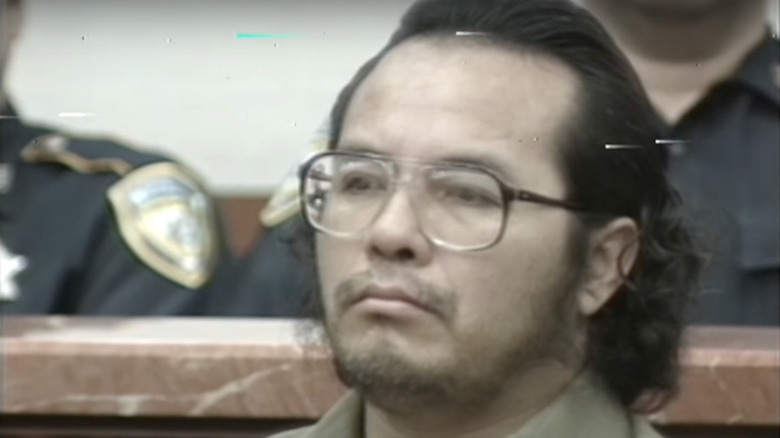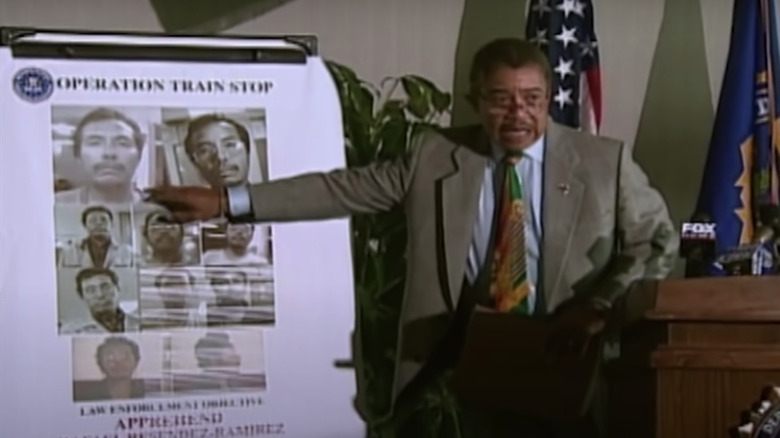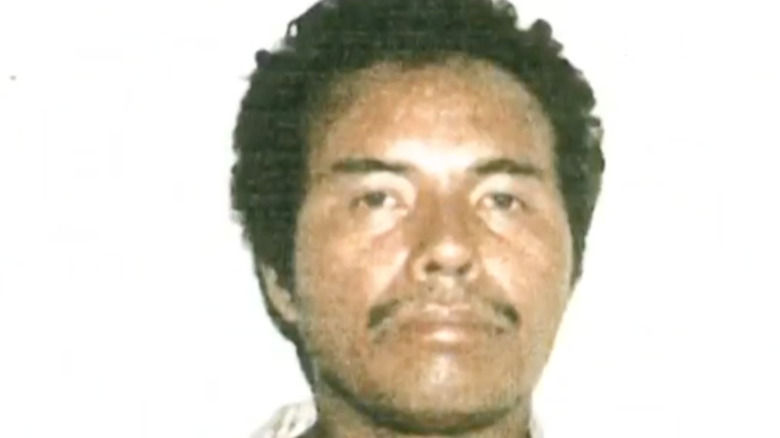Why The Railroad Killer Was Arrested And Released Nine Times In Less Than Two Years
Though many know the names of infamous serial killers Ted Bundy and Jeffrey Dahmer, fewer are aware of murderer Angel Maturino Reséndiz. Known as the Railway Killer, Reséndiz killed up to 23 people as he traveled across the United States (per All That's Interesting). According to Oxygen, Reséndiz was born in Mexico but began to enter the United States illegally as a teenager. He was deported multiple times after committing crimes, including assault and burglary, but he always managed to quickly reenter the U.S.
Reséndiz committed his first murder in 1986, shooting an unidentified homeless woman four times. It was not until 1991 that he would strike again — though he had spent the intervening years in criminality. However, when Reséndiz returned to his killing ways, he moved on to even worse brutality. He began to bludgeon his victims to death, often sexually assaulting his female victims both before and after their deaths. In one particularly gruesome murder, Reséndiz targeted a Texas couple by caving in their skulls with a sledgehammer.
Reséndiz's victims were random and ranged in gender, age, and circumstance. The major commonality is that they generally lived near train tracks. Reséndiz, as a drifter, utilized the railroad system to travel across the country — and it was sadly where he found his prey. Though his use of the railroads gave Reséndiz his name and helped the FBI eventually catch him, his drifter persona tragically helped him evade authorities for years.
A simple way to slip through the cracks
Angel Maturino Reséndiz should have been apprehended years earlier, but his status as an immigrant helped him evade detection. At the time, the governmental body that dealt with immigrants and non-citizens — including illegal entry issues — was the Immigration and Naturalization Services, known as the INS (per Oxygen). It ceased operations in 2003, and its duties have since been transferred to three other governmental outfits: U.S. Immigration and Customs Enforcement, the U.S. Citizenship and Immigration Services, and U.S. Customs and Border Protection.
Verifying the identities of immigrants can be notoriously difficult — but in this case, it was deadly. The INS had Reséndiz in custody nine times in total over just 18 months. However, Reséndiz simply offered a different fabricated name and birth date each time he was detained. Because of this, he was not linked with his grizzly murders and instead was deported to Mexico, at which point he would return to the United States once more.
As noted by All That's Interesting, the most egregious example of the INS's failure is when Reséndiz was apprehended on June 1, 1999, after trying to cross the border in New Mexico. After again giving an alias and being sent back to Mexico, he returned to the United States via Texas just 48 hours later. Once in the Lone Star state again, he committed four murders in the span of just 12 days.
A break in the case
Though Angel Maturino Reséndiz was able to stay under the radar with his immigration status and fake aliases, he was not as stealthy when leaving behind a crime scene. There were multiple cases where he left fingerprints and DNA, as noted by the Associated Press, and the FBI was working on creating a profile for him. The biggest break in the hunt for Reséndiz came when he made a major mistake: He left one of his victims, Holly Dunn, in a field, thinking she was dead. However, she not only survived but also managed to give police a sketch of Reséndiz. "I was staring at every scar he had, every tattoo he had. I was thinking, "Let me remember everything about you that I can, because we'll get you at some point," she recalled in an interview, per CBS News.
In June 1999, the Los Angeles Times finally reported that authorities were on the lookout for a "drifter" of Mexican descent — but even then, they didn't have his real name. Instead, they used Rafael Resendez-Ramirez, one of his aliases. This wasn't the only time the paper used the wrong name, and an amendment at the bottom of the article explains, "Rafael Resendez-Ramirez was later determined to be an alias. Stories July 14-29, 1999 use the name Angel Maturino Resendez; stories after July 29, 1999 use the spelling Angel Maturino Resendiz."
How Reséndiz was finally caught
As the FBI put the pieces of Angel Maturino Reséndiz's crimes together, they released a wanted poster and even placed him on its infamous 10 most wanted list. However, even then, the name on the poster wasn't his real one — it was Rafael Resendez-Ramirez. Fortunately, the poster also included images of Reséndiz, which were verified by Holly Dunn. As the bureau continued to investigate, they figured out his aliases and found something even stranger: His real name was actually Angel Leoncio Reyes Recendis (via the Los Angeles Times). The name that he went by throughout his life, Angel Maturino Resénsiz, was not even the name on his birth certificate.
But while the FBI finally knew Reséndiz's identity, they didn't know his whereabouts. Fortunately, Reséndiz's family decided to come forward and help capture the Railway Killer, and they convinced him to turn himself in. Reséndiz was finally arrested on July 13, 1999, and faced the death penalty in 2006 as punishment for his crimes.
"I know I allowed the devil to rule my life," Reséndiz confessed shortly before his execution, per NBC News.



